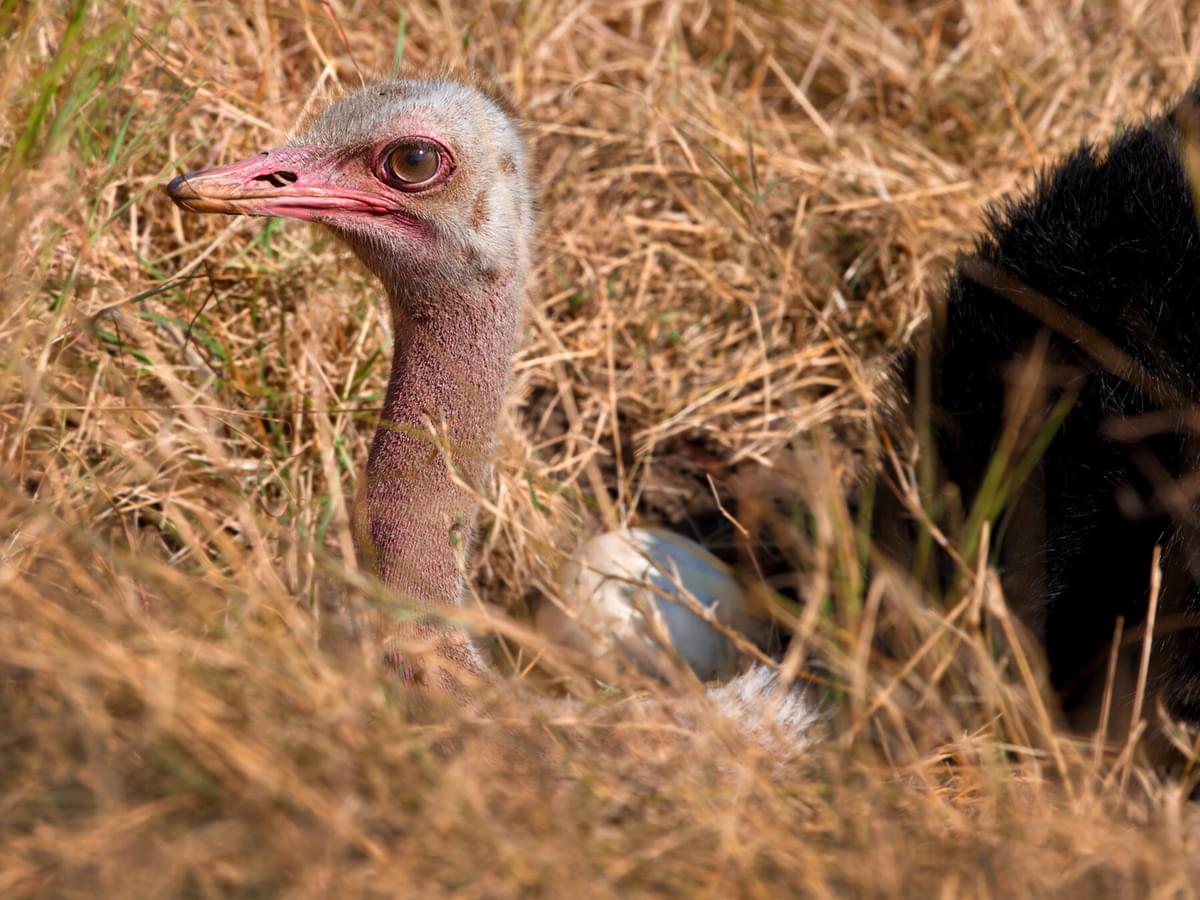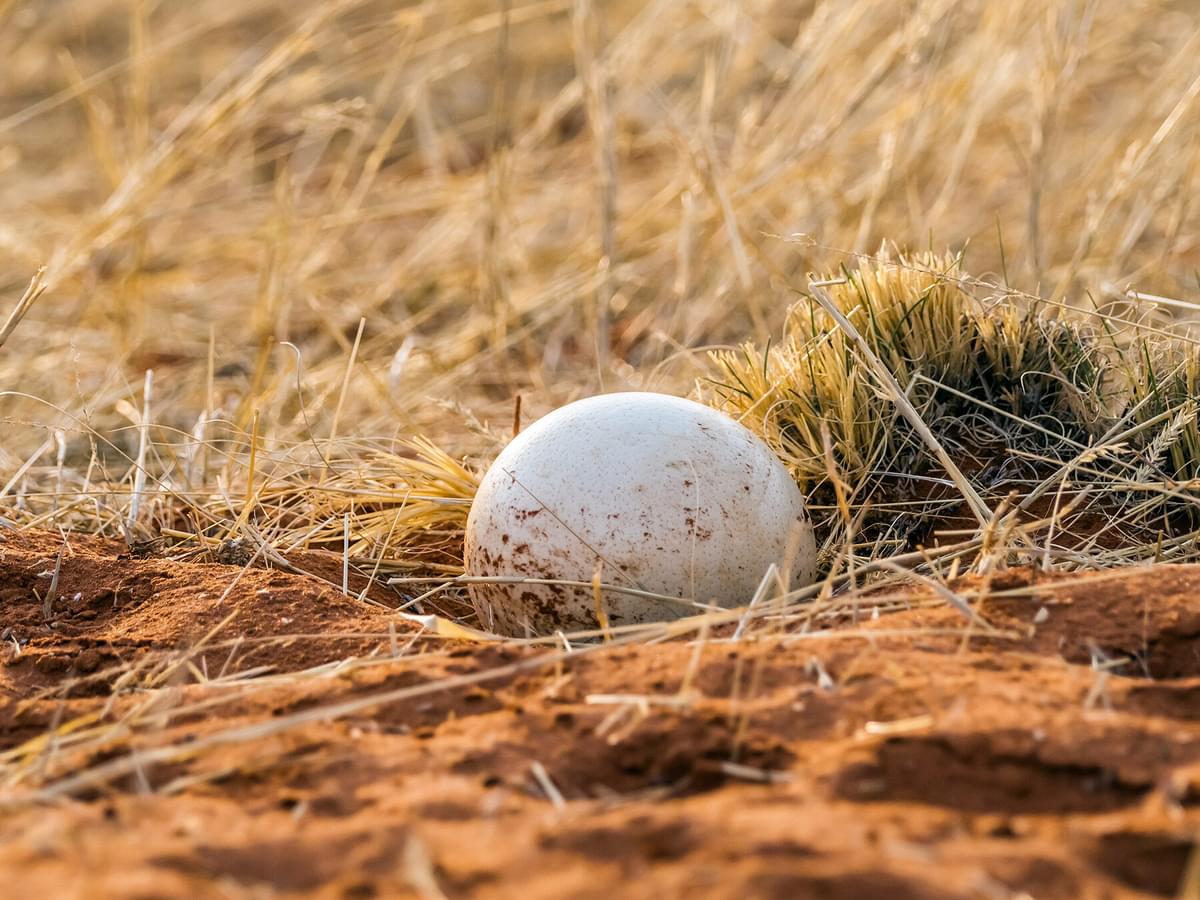Jump to Section
Ostrich Nesting (Behavior, Eggs, Location + FAQs)
Last updated: 9 October 2022

Ostriches are the largest birds in the world by both height and weight. These titanic birds often exceed 130kg and have been recorded obtaining heights of over 2.75m (9ft)!
Ostriches are intriguing in many ways, including their reproduction and nesting habits which are extremely flexible. This is a guide to ostrich nesting.
Ostrich nests are unassuming hollows or pits that measure 30 to 60cm (12 to 24in) deep and 3m (9.8ft) wide. These are scraped into the ground by the male, who chooses the nesting site. Ostriches nest communally, and several females may lay their eggs in the same nest. Most nests contain around 20 eggs, but some are observed to contain something like 50!
The eggs are incubated for some 42 to 46 days, with both males and females participating. When hatched, baby ostriches form large creches of dozens of birds guarded by a ‘supervisor’, which can be either a male or female.
How this complex, flexible breeding and nesting behavior maintains order remains a mystery. While most ostriches do nest communally, some choose to reproduce and nest as solitary pairs.
But of course, there is much more to learn about the quirky nesting behavior of this curious bird - read on to find out!

Male Ostrich sat on the eggs in the nest
Do Ostriches have nests?
Ostriches nests are small, unassuming hollows that are scraped into soft dirt. They’re large, measuring 30 to 60cm (12 to 24in) deep and 3m (9.8ft) wide.
These are sometimes called “dump nests” and are pretty rudimental - they simply hold the eggs in and prevent them from rolling away. Nests aren’t lined with foliage or anything like that; they’re simply scraped into the dirt.
Where do Ostriches nest?
Ostriches typically nest in open areas with good visibility of predators, including grasslands, plains, savannahs, and sparse woodlands and forests.
These types of habitats are available across much of their range. The dominant male chooses the nesting site and scrapes the hollow out, which doesn’t take long.

A female Ostrich watching her nest with eggs inside
What time of year do Ostriches nest?
The ostrich breeding and nesting season is sometimes unpredictable but spans between June to October in East Africa and July to January further south.
Breeding is usually timed with the wet season but has been recorded in the dry season too. Therefore, the breeding season depends on local conditions more than seasonal changes.
How long do Ostriches nest for?
Ostriches nest for as long as they need to hatch their eggs - incubation takes around 42 to 46 days. This long incubation period is due to the size of ostrich eggs - they take a long time to incubate, even despite the hot daytime temperatures of the African savannah.
Once hatched, baby ostriches are guarded closely for 1 to 2 months. They form large creches supervised and patrolled by 1 to 2 adults, which switch with others on a shift basis.
After a couple of months, the young ostriches form juvenile flocks that remain close to adults for the best part of a year.

Ostrich nests are pretty much just scrapes in the ground, nest in Namibia
How do Ostriches build their nests?
At the start of the breeding season, the dominant male ostriches will pick nesting sites. Then, they proceed to scrape at the dirt with their claws to create a depression in the dirt.
Most ostriches nest communally in groups of several females accompanied by a single dominant male.
Breeding flocks keep a distance from each other as the males fiercely defend their harem.
A dominant female, called the ‘major female,’ usually lays her eggs first in the center of the pile. Interestingly, the major female also often lays more eggs than the other females. She also takes care of incubation duties with the male, who tends to incubate at night.

Ostrich sat on the nest incubating eggs
How long does it take an Ostrich to build a nest?
Ostrich nests are very simple and should only take a matter of hours to 'build'. The male scrapes the depression out of dirt, and that’s it - the nest isn’t lined.
When do baby Ostriches leave the nest?
Baby ostriches don’t really have a nestling period. Instead, they’re able to walk and move around shortly after hatching, usually within just days, once they find their feet and gain some strength.
Baby ostriches form communal groups, called creches, which one or two adult ostriches supervise to protect the chicks. They feed themselves and grow quickly, obtaining some adult plumage within six months.

A male Ostrich with his brood of chicks across the grassland of Kenya's Masai Mara
How many broods do Ostriches have?
Female ostriches lay a single clutch of eggs each breeding season.
How many eggs do Ostriches lay in a day?
A female ostrich’s clutch contains between 7 and 18 eggs, more typically 7 to 10. These are laid in intervals of 1 to 2 days between each egg, which makes the laying process quite long from start to finish.
Farmed ostriches can produce 40 to 120 eggs per year under optimal farming conditions.

Ostrich eggs inside the nest, South Africa
Do Ostriches nest in the same place every year?
Ostrich nests are very simple - they’re simply scraped out of the dirt. It’d be extremely unlikely for the nest to be preserved from one year to the next. However, ostriches may return to the same breeding grounds every year.
What do Ostrich eggs look like?
Ostrich eggs are massive, weighing up to 2kg. They are around 15cm (6in) in length and 12.5cm (5in) and have very thick shells with small pits. The shells are a glossy cream color.

Close up of an Ostrich egg
What month do Ostriches lay eggs?
Ostriches lay eggs just before the first rains, which is typically around June to October in East Africa and July to January further south. Breeding has been recorded in the dry season and is probably more sensitive to local conditions than seasonal changes.
Do Ostriches abandon their nests?
Ostriches are fiercely defensive of their nest. After all, some nests contain the eggs of several females and many future ostrich lineages. Ostriches rarely abandon their nests, but if the nest is disturbed and the eggs roll away or break, then they may have no choice.
As you might imagine, an ostrich is not easy to predate, and predators seldom raid nests. Nevertheless, some nests are successfully predated by lions, cheetahs, leopards, and wild dogs. Ostrich eggs are extremely nutritious.

Male Ostrich protecting eggs
Do Ostriches lay eggs without a male?
Ostrich breeding is very flexible. While most males are polygamous and mate with a ‘harem’ of several females, some ostrich couples are faithful and monogamous.
Usually, pregnant females come together to lay their eggs in the same communal nest, but some monogamous pairs of ostriches choose to lay their eggs in isolation from others.
Both males and females incubate eggs. The male usually takes over at night and is well-camouflaged for the night with his dark plumage. Males also help raise young chicks. So, while male ostriches are polygamous, they play a major role in brooding and rearing chicks.

Family of ostriches drinking water from a pool in the hot sun of the Kalahari
Why do Ostriches bury their heads in their nests?
There’s a well-known myth that ostriches bury their heads in the sand when threatened. This couldn’t really be further from the truth - a threatened ostrich will either run away or attack, and their huge claws and powerful kicks can kill a human or a lion in one strike!
This myth originates from ostrich behavior which sees them reach into their nest with their head to turn their eggs.
Since ostrich nests are indented into the ground, the base of the nest gets very cold at night. Ostriches turn the eggs to ensure they’re heated evenly during incubation. This makes it look like the ostrich is burying its head in the sand.
On this page
- Do Ostriches have nests?
- Where do Ostriches nest?
- What time of year do Ostriches nest?
- How long do Ostriches nest for?
- How do Ostriches build their nests?
- How long does it take an Ostrich to build a nest?
- When do baby Ostriches leave the nest?
- How many broods do Ostriches have?
- How many eggs do Ostriches lay in a day?
- Do Ostriches nest in the same place every year?
- What do Ostrich eggs look like?
- What month do Ostriches lay eggs?
- Do Ostriches abandon their nests?
- Do Ostriches lay eggs without a male?
- Why do Ostriches bury their heads in their nests?






